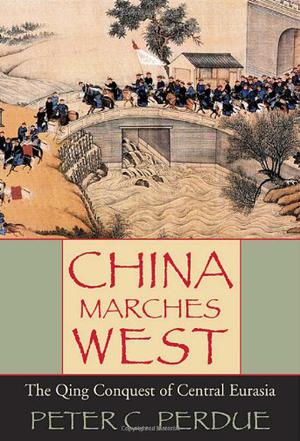
章节目录
List of Maps* Preface Acknowledgments Note on Names, Dates, Weights and Measures, and Chinese Characters Introduction History, Time, and Memory The Qing Conquests as a World Historical Event I. The Formation of the Central Eurasian States 1. Environments, State Building, and National Identity The Unboundedness of Central Eurasia Trade, Transport, and Travel The Frontier Zone Isolation and Integration 2. The Ming, Muscovy, and Siberia, 1400–1600 The Ming and the Mongols State Formation in Muscovy and Russian Expansion Siberian and Chinese Frontiers 3. Central Eurasian Interactions and the Rise of the Manchus, 1600–1670 Building the Zunghar State The Rise of the Manchus Mongolian Influence on the Manchu State Early Modern State Building Compared II. Contending for Power 4. Manchus, Mongols, and Russians in Conflict, 1670–1690 Kangxi the Ruler Galdan’s Intervention Kangxi’s First Personal Expedition The Treaty of Nerchinsk and the Excluded Middle 5. Eating Snow: The End of Galdan, 1690–1697 The Dolon Nor Assembly The Battle of Jao Modo The Emperor Rewrites History The Final Campaigns and the Fate of Galdan 6. Imperial Overreach and Zunghar Survival, 1700–1731 The Rise of Tsewang Rabdan Three Central Eurasian Travelers The Penetration of Turkestan and Tibet The New Emperor Changes Tack 7. The Final Blows, 1734–1771 Transforming the Barbarians through Trade The Death Knell of the Zunghar State The Conquest of Turkestan The Return of the Torghuts III. The Economic Basis of Empire 8. Cannons on Camelback: Ecological Structures and Economic Conjunctures Galdan the State Builder Nian Gengyao and the Incorporation of Qinghai Administering the Frontier 9. Land Settlement and Military Colonies Deportation from Turfan Settlement of Xinjiang Colonization and Land Clearance Economic Development 10. Harvests and Relief Harvests and Yields Granary Reserves The Contribution Scandal The Relief Campaign of 1756 11. Currency and Commerce Money on the Frontier, from Song through Ming Integration and Stabilization Commerce as a Weapon of War Tribute and Frontier Trade IV. Fixing Frontiers 12. Moving through the Land Travel and Authority Marking Space in Stone Maps and Power Expanding the Imperial Gaze 13. Marking Time: Writing Imperial History Kangxi’s Campaign History Yongzheng and the Dayi Juemilu Qianlong’s Account of the Zunghar Mongols A View from the Frontier Nomadic Chronicles V. Legacies and Implications 14. Writing the National History of Conquest Statecraft Writers and Empire Geopolitics and Emperor Worship Chinese Historians and the Multicultural State Soviet and Mongolian Attacks on Qing Aggression Empires, Nations, and Peoples 15. State Building in Europe and Asia The Political Ecology of Frontier Conquest European, Chinese, and Inner Asian Models Theories of Nomadic Empires Rethinking the Qing in the World 16. Frontier Expansion in the Rise and Fall of the Qing The End of the Qing State Northwest and Southern Frontiers The Negotiated State Commercialization and Regionalization Appendixes A. Rulers and Reigns B. The Yongzheng Emperor Reels from the News of the Disaster, 1731 C. Haggling at the Border D. Gansu Harvests and Yields E. Climate and Harvests in the Northwest Abbreviations Notes Bibliography Illustration Credits Index * Maps 1. The Qing empire, ca. 1800 2. The Zunghar empire 3. Ecological zones of Eurasia 4. Tribal peoples and Russian settlements in the sixteenth and seventeenth centuries 5. The Sino–Russian frontier 6. The Kangxi emperor’s Zunghar campaigns, 1690–1697 7. The Qianlong emperor’s western campaigns, 1755–1760 8a. Grain price integration in Gansu, 1739–1864 8b. Grain price integration in Gansu with famine years omitted, 1739–1864 9. Grain price integration in Xinjiang, 1777–1860
内容简介
From about 1600 to 1800, the Qing empire of China expanded to unprecedented size. Through astute diplomacy, economic investment, and a series of ambitious military campaigns into the heart of Central Eurasia, the Manchu rulers defeated the Zunghar Mongols, and brought all of modern Xinjiang and Mongolia under their control, while gaining dominant influence in Tibet. The China we know is a product of these vast conquests. Peter C. Perdue chronicles this little-known story of China’s expansion into the northwestern frontier. Unlike previous Chinese dynasties, the Qing achieved lasting domination over the eastern half of the Eurasian continent. Rulers used forcible repression when faced with resistance, but also aimed to win over subject peoples by peaceful means. They invested heavily in the economic and administrative development of the frontier, promoted trade networks, and adapted ceremonies to the distinct regional cultures. Perdue thus illuminates how China came to rule Central Eurasia and how it justifies that control, what holds the Chinese nation together, and how its relations with the Islamic world and Mongolia developed. He offers valuable comparisons to other colonial empires and discusses the legacy left by China’s frontier expansion. The Beijing government today faces unrest on its frontiers from peoples who reject its autocratic rule. At the same time, China has launched an ambitious development program in its interior that in many ways echoes the old Qing policies. China Marches West is a tour de force that will fundamentally alter the way we understand Central Eurasia.
下载说明
1、China Marches West是作者Peter C. Perdue创作的原创作品,下载链接均为网友上传的网盘链接!
2、相识电子书提供优质免费的txt、pdf等下载链接,所有电子书均为完整版!
下载链接
热门推荐
- 1 动物园长夫人
- 2 不再努力成为另一个人
- 3 热爱生活的一万个理由
- 4 专家的窘境
- 5 艺术的旅程
- 6 出版的正反面
- 7 批判性思维训练手册
- 8 纵乐的困惑
- 9 黑白之城
- 10 狂飙
